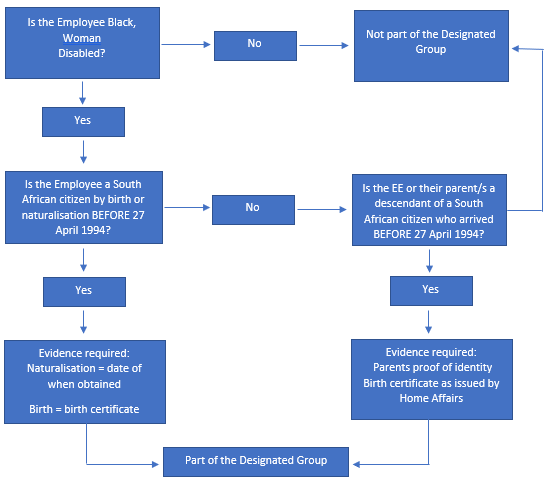At Global Business Solutions we strive to provide organisations with practical solutions.
With this in mind, our Employment Equity Experts created a checklist and flowchart to help EE managers determine whether or not an employee is part of a Designated Group.
How to determine if an Employee is part of a Designated Group
The EEA 1 form is a compulsory declaration form which must be completed by all employees to ensure the accuracy of information regarding the demographics for all employees such as race, gender, and disability status.
It is used to establish if under-representations of designated groups exist and is, therefore, a very important form to be completed.
Useful definitions for completing the EEA1 form
- Designated Groups means historically disadvantaged South African born, naturalised citizens who are Black, women and/or living with a disability.
- Black is inclusive of African, Coloured, Indian people
- Women includes all women (African, Coloured, Indian and White)
- Persons living with disabilities includes all persons with disabilities regardless of race and gender
- Foreign National means a person not born in South Africa and who does not have citizenship. This term will also apply to any person who obtained citizenship after 27 April 1994 and who does not qualify as part of the designated group as per the definition contained within this document. (This includes people with permanent residence).
Flowchart to determine if an employee is part of a Designated Group

Tips to define Designated Groups for EEA and BEE reporting
- ID document for permanent residency or non-SA citizen – if the last 3 digits of the ID ends with (18-). This will indicate that the employee with this ID number is part of the Non-Designated Group as he/she is a permanent resident only.
- Gender identity determination (19930605) year of birth/month/date, the next two digits 0-4 denotes female and 5-10 Males.
- If the employee is Black, woman or living with a disability and the birth certificate shows place of birth not in SA but country of birth is South Africa, this would mean the employee is part of the Designated Group. This is where for example, a child is born outside of SA in another country, but they are SA Citizens as the birth certificate is issued in that country as a record of birth, but the parents still needed to come back to SA to register the birth in SA.
- Both parents, who are Black, are now South African citizens but they were not born/naturalised/descendants of South Africa before 27th April 1994, this would mean the employee is part of the Non-Designated Group.
- One Black parent is born/naturalised/descendant in South Africa before 27th Africa 1994, this would mean the employee is part of the Designated Group.
If you are interested in learning more about how our Employment Equity training and services can benefit your organisation, please contact me on [email protected]



